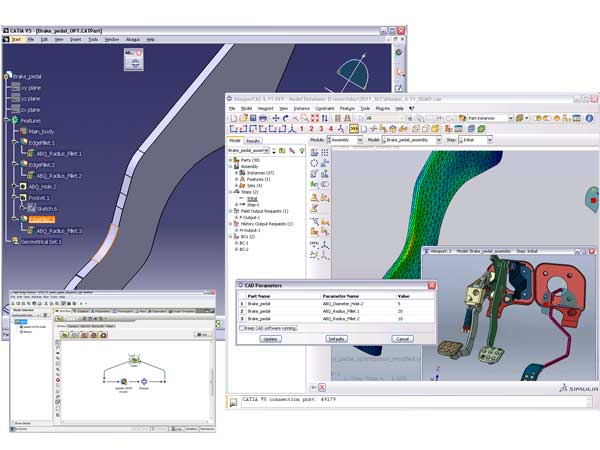Dassault Systemes SIMULIA’s Abaqus 6.11 Delivers New Simulation Technology
Nonlinear structural optimization, electromagnetic analysis, and GPU-support highlight latest release of Abaqus.
Latest News
May 18, 2011
By DE Editors
Dassault Systemes has announced new nonlinear structural optimization, coupled multiphysics, and high-performance computing technology available in Abaqus 6.11, the simulation product suite from SIMULIA.

Abaqus 6.11 introduces an enhanced CATIA V5 interface, which now supports bidirectional associativity, with Abaqus providing seamless parameter updating for design iterations. When driven by parameter-optimization software, such as Isight, this functionality allows the parametric execution of design of experiments (DOE) and optimization studies.
The company says the new release incorporates more than 100 customer-requested enhancements.
“Meeting our customers’ demands to simulate the true-to-life behavior of their products drives our strategy of developing the most innovative and robust realistic simulation solutions possible,” says Pat Cadrin, director of product management, SIMULIA, Dassault Systemes. “With Abaqus 6.11, we have delivered new capabilities that allow users to analyze a broader range of multiphysics problems, leverage the latest high performance computing technologies, and accelerate the optimization of their designs. This release clearly demonstrates our commitment to enabling our customers to be more productive and efficient, and therefore more competitive in their race-to-market.”
Abaqus 6.11 marks the first release of the Abaqus Topology Optimization Module (ATOM). This add-on product enables Abaqus users to perform topology and shape optimization for single parts and assemblies, while taking into account large deformation, material nonlinearity and contact.
Abaqus 6.11 also introduces a new electromagnetics solution technology to solve problems requiring time-harmonic eddy current analysis, such as the hardening of a bearing surface due to induction. In addition, this release provides a new smoothed particle hydrodynamics capability for modeling violent free-surface flows, such as fluid sloshing.
Additionally, customers will benefit from improved performance in Abaqus 6.11, including support for graphics processing units (GPU). “The ability to run more design candidates while shortening engineering cycles is the future of computer-aided engineering,” says Andrew Cresci, general manager of strategic alliances in NVIDIA’s Professional Solutions Group. “CUDA-based GPU acceleration in Abaqus 6.11 can provide a 2x speed up for a range of models and industries, helping SIMULIA customers dramatically improve their workflow and deliver higher quality products to market, faster.”
For more new Abaqus 6.11 features and enhancements visit SIMULIA.
Sources: Press materials received from the company and additional information gleaned from the company’s website.
Subscribe to our FREE magazine, FREE email newsletters or both!
Latest News
About the Author
DE’s editors contribute news and new product announcements to Digital Engineering.
Press releases may be sent to them via [email protected].






